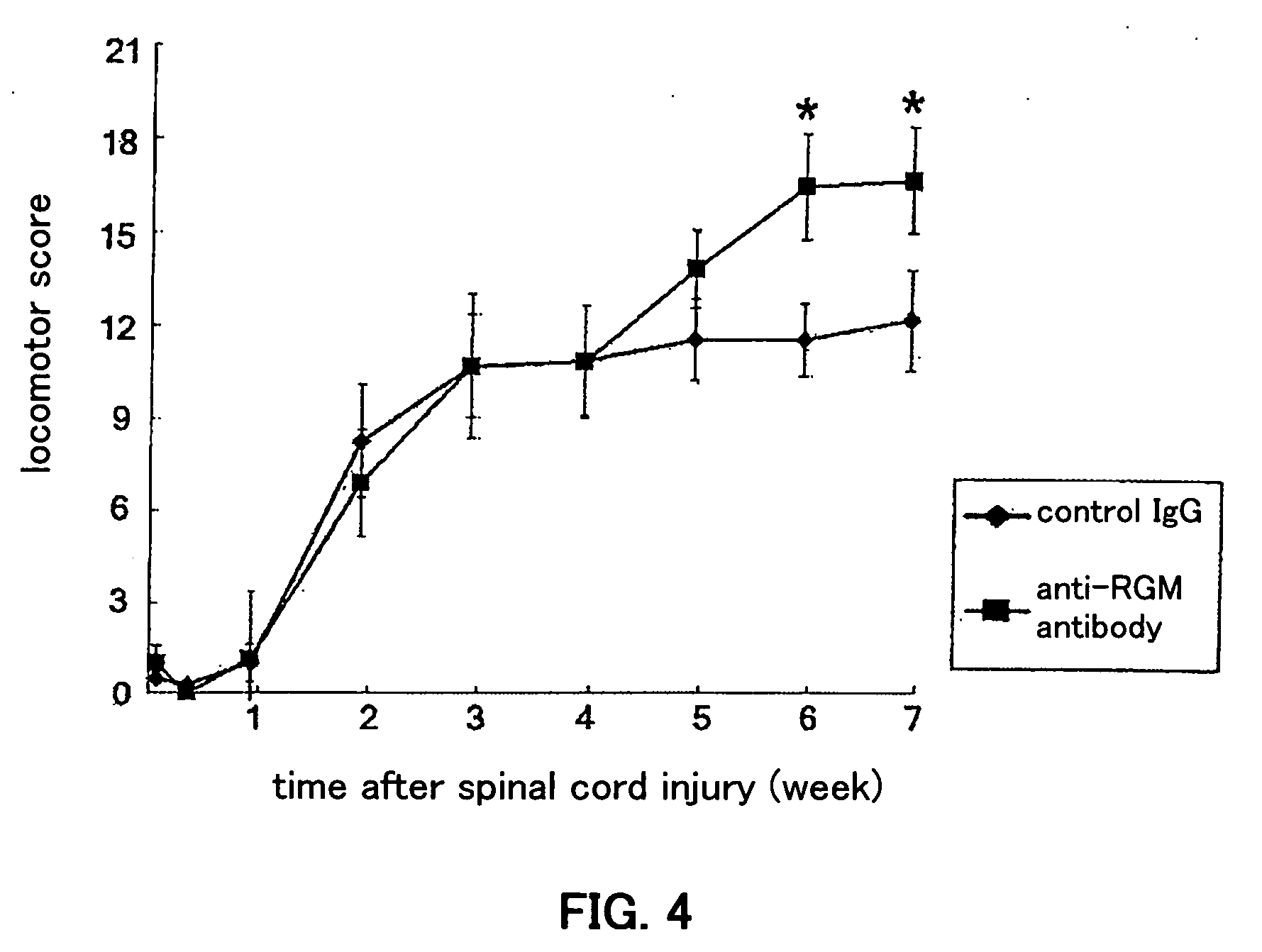Axon Regeneration Promoter
- Summary
- Abstract
- Description
- Claims
- Application Information
AI Technical Summary
Benefits of technology
Problems solved by technology
Method used
Image
Examples
example 1
[0081] A BLAST search of the GenBank database was performed using the amino acid sequence of chicken RGM (P. P. Monnier et al., Nature 419, 392-5 (Sep. 26, 2002)) as the query. Rat cDNA with accession no. XM—218791 (Rattus norvegicus) was identified as a result. The putative amino acid sequence showed 79% homology with chicken RGM protein and for this reason XM—218791 was designated rat RGM-like protein. Full-length rat RGM-like protein cDNA was isolated by PCR from an adult rat brain cDNA library. The nucleotide sequence of the forward primer used was agtggtaacaggccgagctggatgg (SEQ ID NO: 5); the nucleotide sequence of the reverse primer was ccacaaccttgtcgcgtgcactaat (SEQ ID NO: 6); PCR comprised 25 cycles of denaturation for 30 seconds at 95° C., annealing for 30 seconds at 55° C., and elongation for 3 minutes 30 seconds at 72° C. The encoded protein consisted of 431 amino acid residues. Native rat RGM was presumed to began at 152aa based on the previous ...
example 2
1. Methods
(1) Surgical procedure
[0099] Anesthetized (sodium pentobarbital, 40 mg / kg) female Wistar rats (200-250 g) received a laminectomy at vertebral level T9 / 10 and the spinal cord was exposed. The dorsal part of the spinal cord was cut to a depth of 1.8 mm using a number 11 blade. According to histologic examination, in all animals these lesions severed all the dorsal corticospinal tract (CST) fibers in the posterior column as well as the lateral corticospinal tract and extended past the central canal. This spinal cord hemisection was immediately followed by fitting with an osmotic pressure minipump (200 μL solution, 0.5 μL / hour, 14-day delivery, from Durect Corp., Cupertino, Calif., USA) filled with control antibody (8 animals, 22.3 μg / kg·day, 2 weeks) or the anti-RGM-like protein antibody generated in Example 1 (8 animals, 22.3 μg / kg·day, 2 weeks). The minipump was placed under the skin on the animal's back, and a silicone tube connected to the outlet of the minipump was p...
example 3
1. Method
(1) Affinity Precipitation of GTP-RhoA
[0107] Cells were lysed in 50 mM Tris (pH 7.5) containing 1% Triton X-100™, 0.5% sodium deoxycholate, 0.1% SDS, 500 mM NaCl, 10 mM MgCl2, 10 μg / mL leupeptin, and 10 μg / mL aprotinin. The cell lysate was cleared by centrifugation at 4° C. for 10 minutes×13000 g, and the supernatant was incubated for 45 minutes at 4° C. with 20 μg GST-Rho binding domain of Rhotekin beads (TM, Upstate Biotech). The beads were washed four times with washing buffer (50 mM Tris (pH 7.5) containing 1% Triton X-100™, 150 mM NaCl, 10 mM MgCl2, and 10 μg / mL each of leupeptin and aprotinin). Bound Rho was detected by Western blotting using monoclonal antibody against RhoA (Santa Cruz Biotech, Santa Cruz, Calif., USA).
2. Results
(2) Affinity Precipitation of GTP-RhoA
[0108] The RhoA activity in neurons was measured. Conditioned medium was added to cerebellar neurons from 7-day postnatal rats and the RhoA activity was measured after 30 minutes had elapsed (FIG...
PUM
 Login to View More
Login to View More Abstract
Description
Claims
Application Information
 Login to View More
Login to View More - R&D
- Intellectual Property
- Life Sciences
- Materials
- Tech Scout
- Unparalleled Data Quality
- Higher Quality Content
- 60% Fewer Hallucinations
Browse by: Latest US Patents, China's latest patents, Technical Efficacy Thesaurus, Application Domain, Technology Topic, Popular Technical Reports.
© 2025 PatSnap. All rights reserved.Legal|Privacy policy|Modern Slavery Act Transparency Statement|Sitemap|About US| Contact US: help@patsnap.com



